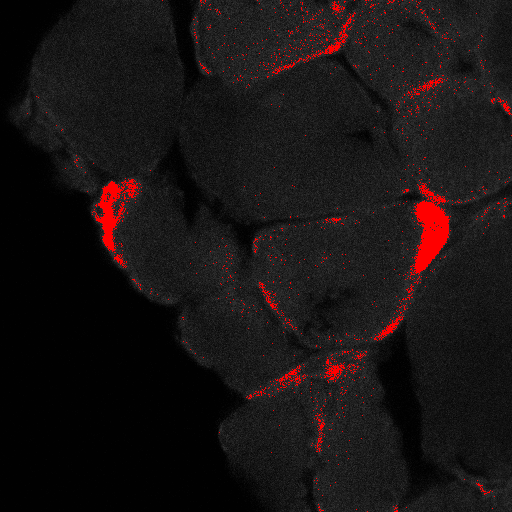Selecting a masked/overlayed object
|
Hi,
I am using Imagej to calculate the thresholded area and intensity of a selected area of staining (endplate receptor cluster and nerve terminal of neuromuscular junction) of two fluorescent channels. There are more than one staining areas (endplates) and I would like to calculate their intensity and area individually. I want to use the same area calculated by thresholding and transfer this area to the other channel. I can transfer the area surrounding the staining on one channel to the other. I do this by thresholding the channel. Then I use edit -> selection -> create selection. This creates a 'mask' of the area of the channel that is shown on both channels. However, I cannot use the polygon or freehand selection tools to isolate the area of staining that i would like to consider (individual endplate). When i threshold and measure it calculates the total intensity within all regions of staining (multiple endplates). Can someone help me with selecting an individual endplate when I have masked certain areas of the image 
|
|
Hi,
You have to use the ROI manager. On you thresholded image draw your region of interest with the tool you need. Type "t" to have your region in the ROI manager. Select the image on which you want to measure and clink on measure on the Roi manager. I wish it helps !! Eric Denarier Grenoble Institut des Neurosciences Inserm U836 Chemin Fortuné Ferrini 38700 La Tronche France Tél :33 (0)4 56 52 05 38 Fax :33 (0)4 56 52 06 57 http://neurosciences.ujf-grenoble.fr/ Le 25/09/2013 06:09, ntse163 a écrit : > Hi, > I am using Imagej to calculate the thresholded area and intensity of a > selected area of staining (endplate receptor cluster and nerve terminal of > neuromuscular junction) of two fluorescent channels. There are more than one > staining areas (endplates) and I would like to calculate their intensity and > area individually. I want to use the same area calculated by thresholding > and transfer this area to the other channel. > > I can transfer the area surrounding the staining on one channel to the > other. I do this by thresholding the channel. Then I use edit -> selection > -> create selection. > > This creates a 'mask' of the area of the channel that is shown on both > channels. However, I cannot use the polygon or freehand selection tools to > isolate the area of staining that i would like to consider (individual > endplate). When i threshold and measure it calculates the total intensity > within all regions of staining (multiple endplates). > > Can someone help me with selecting an individual endplate when I have masked > certain areas of the image > <http://imagej.1557.x6.nabble.com/file/n5004930/masked_nerve_channel.png> > > > > -- > View this message in context: http://imagej.1557.x6.nabble.com/Selecting-a-masked-overlayed-object-tp5004930.html > Sent from the ImageJ mailing list archive at Nabble.com. > > -- > ImageJ mailing list: http://imagej.nih.gov/ij/list.html -- ImageJ mailing list: http://imagej.nih.gov/ij/list.html |
|
Hi,
I cannot draw the region of interest I require as this removes the 'mask' or outline of the area that I created, in the 2nd channel. If i do this in reverse and draw the region of interest first, the region of interest is removed when I create the mask. I need to keep the mask and draw the region of interest. Would this be possible? If not, is there an alternative to masking the area that I could use? I need to select the exact area of staining in a region of interest in one channel and apply this area to the other channel. I am trying to determine the amount of staining, in the region of interest, in the 2nd channel that corresponds to the staining in the 1st channel |
«
Return to ImageJ
|
1 view|%1 views
| Free forum by Nabble | Edit this page |

